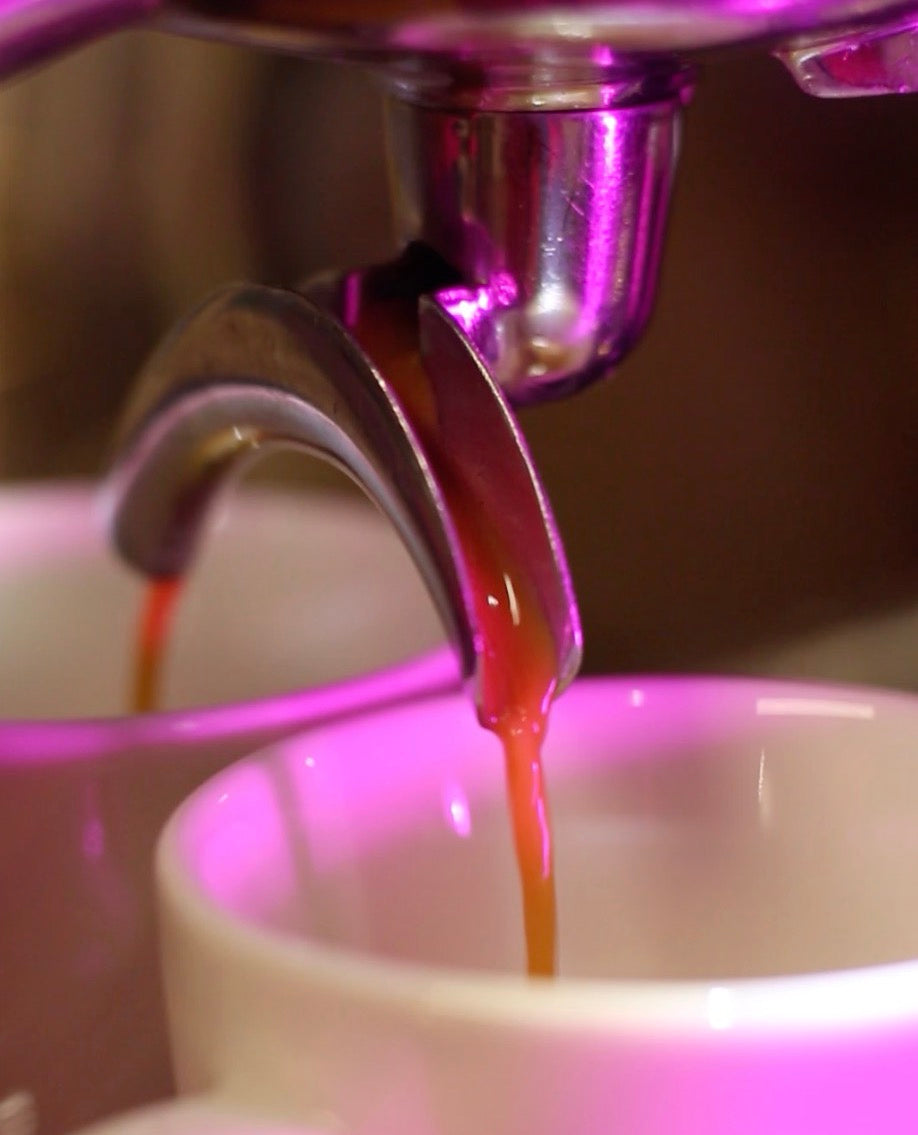NinetyPlus Panamá Gesha Juliette
Información del Café
Juliette es un café que pertenece a la línea Signature de NinetyPlus, y el nombre se refiere al proceso post-cosecha por el cual pasa el café. Este proceso, similar al proceso honey, se ha refinado hasta el punto de ser una fórmula de renombre.
Ha sido utilizado dos veces para obtener el primer lugar en el Campeonato Baristas de China (por el competidor Jeremy Zhang) y es uno de los lotes más dulces que produce NinetyPlus. Lo describen como "un rosé contrapuesto al vino blanco o tinto; toda la claridad característica del perfil floral y cítrico de Gesha, pero en balance con profundidad y cremosidad en su estructura".
Productor: NinetyPlus Estates, Joseph Brodsky.
País: Panamá.
Región: Silla de Pando, Volcán Barú.
Altitud: 1500 - 1700 mts.
Variedad: Gesha.
Proceso post-cosecha: Fermentación en seco y secado en mucílago.
Cosecha: Abril 2021.


Fotografías proporcionadas por NinetyPlus.
Descripción Sensorial
Manzanilla, jazmín, cáscara de naranja, vainilla, durazno blanco, crema pastelera, dulce de leche, crème brûlée, violeta, regaliz, miel.
Acidez media estructurada, dulzor medio–alto redondo y amargor bajo delicado.
Cuerpo ligero, textura sedosa y un suave final aromático.
Importación
Este café fue comprado de manera directa a NinetyPlus Estates, sin ningún tipo de intermediario. El kilo de café en verde costó USD $180 —52 veces el precio C al momento de la compra—, y el costo de importación fue de aproximadamente USD $220, lo que lleva el total de costo a unos USD $400/kilo . Esto no incluye costos de operación, diseño o packaging —desarrollado en conjunto con Jorge Navajas—.
Además, en la compra de este café, se donaron USD $5 para plantar un árbol en el Parque Nacional Volcán Barú, en Panamá. NinetyPlus Estates contribuye directamente a que el cultivo de café sea responsable con el ecosistema y mantenga la biodiversidad, con inspiración en los bosques y variedades nativas de Etiopía.
Tueste
El desafío de tostar este café, además de considerar su alto costo, fue transferir suficiente energía a la semilla. En tuestes similares a los de otros cafés dentro de nuestra oferta, los sabores no estaban lo suficientemente marcados; por lo que decidimos aplicar un tueste un tanto más lento para desarrollarlo adecuadamente.
Tostadora: Kaffelogic Nano 7
Carga: 80 gramos
Humedad Inicial: 10,8%, rehidratado al 16%
Tiempo Total: 9 minutos, 45 segundos
DTR: 15,9%
Temperatura Final: 219,5 ºC
Temperatura Acumulada* : 15,7
Pérdida de masa: 18,5%

*Calculamos este valor dividiendo el área debajo de la curva de tueste por la carga, ( [ºC x min] / gramos). Consideramos que este valor, en nuestra tostadora, es una aproximación razonable del desarrollo del café, en sentido amplio.
Agua
Tu café incluye un concentrado de minerales hecho en conjunto con Javier de la Vega, de Your Water, con nuestra receta de agua.
La idea de incluir este concentrado es que tus resultados puedan ser lo más similares a los que nosotros tenemos al catar y preparar el café. Nuestra receta de agua busca la mayor extracción posible, y un balance entre acidez, dulzor y amargor.
Diluye el concentrado de minerales en un bidón de 5 litros de agua destilada, de osmosis inversa, o con hasta 7 ppm. También puedes usar algo como agua Benedictino o Aguas Nómade. Agitar levemente durante 5 segundos y finalmente, esperar 20 segundos para su uso.
Receta:
— 185 ppm** de Dureza (MgSO₄)
— 38 ppm** de Alcalinidad o Buffer (NaHCO₃)
**Como equivalencia en CaCO3.
Preparación
En general, nuestros cafés están pensados para extracciones altas. Recomendamos moliendas finas, temperaturas más altas, y ratios más largos —para filtrados, entre 1:20 y 1:23; para espresso, entre 1:3 y 1:5—. Además, solemos preferir concentraciones relativamente bajas, donde encontramos la mayor claridad en descriptores.
La idea de incluir recetas recomendadas no es evitar que experimentes con el café, sino comunicar la recetas con las que nosotros hemos tenido buenos resultados.
Hario V60 o Similar
Dosis: 10 gramos.
Agua: 200 gramos, receta incluida.
Bebida: 170 - 180 gramos.
Tiempo: 5 - 7 minutos.
Temperatura: Hirviendo; 97ºC en Santiago.
TDS: 1.3 - 1.4%.
Primer vertido —saturación o bloom— de 30 gramos, mover la cafetera por 5 segundos asegurando que todo el café esté mojado.
Segundo vertido de 35 gramos (65) a los 30 segundos. Mover la cafetera suavemente en círculos por 2 segundos.
Tercer vertido de 35 gramos (100) justo antes de que el nivel del agua llegue al café. Mover la cafetera suavemente en círculos por 2 segundos.
Cuarto vertido de 35 gramos (135) justo antes de que el nivel del agua llegue al café. Mover la cafetera suavemente en círculos por 2 segundos.
Quinto vertido de 35 gramos (170) justo antes de que el nivel del agua llegue al café. Mover la cafetera suavemente en círculos por 2 segundos.
Vertido final de 30 gramos (200) justo antes de que el nivel del agua llegue al café. Mover la cafetera suavemente en círculos por 2 segundos.
Se recomienda llegar previamente a algo cercano a estos parámetros con otro café. Intentar que todos los vertidos se hagan desde la mayor altura posible que no genere turbulencia en la superficie del agua, en un movimiento circular sobre el café y manteniendo un flujo controlado. Además, se recomienda mantener el agua hirviendo entre vertidos.
AeroPress
Dosis: 10 gramos.
Agua: 200 gramos, receta incluida.
Bebida: 185 - 195 gramos.
Tiempo: 8 - 9 minutos.
Temperatura: Hirviendo; 97ºC en Santiago
TDS: 1.3 - 1.4%
[Método estándar.]
Verter los 200 gramos de agua sobre el café, procurando verter desde la mayor altura posible que no genere turbulencia en la superficie del agua, y asegurándose de mojar todo el café de manera uniforme.
Insertar el émbolo sin aplicar presión para generar un vacío.
A los 2 minutos, con el émbolo todavía inserto, mover la cafetera suavemente en círculos por 5 segundos.
A los 4 minutos, con el émbolo todavía inserto, mover la cafetera suavemente en círculos por 5 segundos.
A los 7 - 8 minutos, comenzar a presionar el émbolo de manera muy suave; presionar más allá del sonido del aire.
Se recomienda llegar previamente a algo cercano a estos parámetros con otro café, y utilizar la molienda más fina con la que sea fácil presionar el émbolo de manera suave.
Espresso
Dosis: 15 gramos.
Agua: El agua que uses en tu máquina de espresso, o la receta incluida, si tienes una máquina que te lo permite con facilidad.
Bebida: 45-50 gramos.
Tiempo: 15-20 segundos.
Presión desde bomba: 6 bar
Temperatura: 96-97ºC
TDS: 7 - 8%
Se recomienda llegar previamente a algo cercano a estos parámetros con otro café. Para algo como un allongé, utilizar los mismos parámetros, pero apuntar a una bebida de 75 - 90 gramos.
Tricolate
Dosis: 10 gramos.
Agua: 200 gramos, receta incluida.
Bebida: 170 - 180 gramos.
Tiempo: 9 - 13 minutos.
Temperatura: Hirviendo; 97ºC en Santiago
TDS: 1.3 - 1.5%
Primer vertido —saturación o bloom— de 30 gramos, mover la cafetera por 10 segundos asegurando que todo el café esté mojado.
Segundo vertido de 70 gramos (100) a los 60 segundos. Mover la cafetera suavemente en círculos por 2 segundos.
Tercer vertido de 100 gramos (200) a los 120 segundos. Mover la cafetera suavemente en círculos por 2 segundos.
Se recomienda llegar previamente a algo cercano a estos parámetros con otro café. Además, se recomienda mantener el agua hirviendo entre vertidos.
Música
Todos nuestros cafés incluyen también una lista de Spotify, con canciones que nos gusta escuchar al prepararlo y beberlo. En general, las canciones que incluimos en cada lista tienen relación con algunos aspectos sensoriales del café; pero explicar exactamente cómo se relacionan va más allá de las palabras.
Escucha NinetyPlus Panamá Gesha Juliette en Spotify

